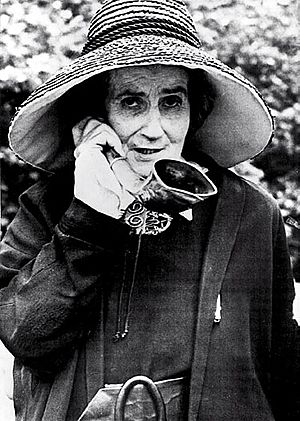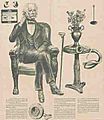History of hearing aids facts for kids
Imagine a world where sounds are hard to hear. For a long time, people with hearing problems needed help. The first modern hearing aids appeared in the 1600s. But even before that, as early as the 1200s, people were trying to make similar tools by hollowing out animal horns. These early devices didn't get much better until electricity and the telephone were invented in the late 1800s. That's when the first electric hearing aid was created. Over the last 100 years, technology has changed hearing aids a lot, making them smaller and much more helpful.
Contents
Early Ear Trumpets
The very first hearing aids were called ear trumpets. They looked like large funnels and were often made from metal, animal horns, wood, or even snail shells. People would hold these devices up to their ear when they wanted to hear better.
These ear trumpets didn't make sounds louder. Instead, they worked by gathering sound waves and directing them into the ear. This made the sound energy stronger when it reached the eardrum. This simple design helped people with hearing loss to hear more easily.
For ear trumpets to work best, someone usually had to speak directly into the wide opening of the trumpet. In noisy places like concerts, they weren't very effective. They couldn't block out background noise, so all sounds, both wanted and unwanted, would enter the trumpet.
Electronic Hearing Aids
In the late 1800s, after the invention of telephones and microphones, electric hearing aids were developed. Even though they were made between the 1870s and 1890s, they didn't become widely used until the early 1900s.
The first electronic hearing aid was called the Akouphone. It was invented by Miller Reese Hutchinson. This device used a special part called a carbon transmitter, which was created by Thomas Edison. It could make sound about 15 decibels louder. It did this by using an electric current to boost the sound signal.
These early electronic hearing aids were portable, but they were still quite large and not easy to carry around. They also sometimes made a scratchy noise and couldn't pick up all sounds clearly. So, they weren't perfect.
Vacuum Tube Devices
In 1920, a new type of hearing aid was created by Earl Hanson, a naval engineer. These were called vacuum-tube hearing aids. Like the earlier electronic aids, they used a transmitter, similar to those found in telephones, to make sounds louder.
These devices worked by changing sound into an electronic current, making that current stronger, and then sending it to the ear. Vacuum tubes could increase sound by up to 70 decibels. They worked better because they could control electricity more precisely than carbon could.
At first, these vacuum-tube hearing aids were as big as a cabinet! But between the 1920s and 1930s, they were made smaller, fitting into a small box. By the late 1940s, a device that could fit into a pocket was made. However, this pocket device still needed wires connecting to the ears, which many people found inconvenient.
Transistor Technology
Eventually, vacuum tubes were replaced by much smaller and better parts called transistors. Transistors were not only tiny but also used less power and made sounds clearer than vacuum tubes.
Because transistors were so small, hearing aids could finally be worn inside or behind the ear. This made hearing aids much more popular and easier for people to use every day.
Digital Hearing Aids
Later in the 1900s, transistors began to be made from silicon. This allowed hearing aids to become even smaller. Microprocessors, which are like tiny computers, were also added to hearing aids. This meant that sound signals could be processed digitally.
This digital technology eventually allowed hearing aids to be programmed. They could be customized to fit the specific hearing needs of each person. The technology inside modern hearing aids is similar to what you find in mobile phones, computers, and televisions today!
Images for kids
See also
 In Spanish: Historia de los auxiliares auditivos para niños
In Spanish: Historia de los auxiliares auditivos para niños







